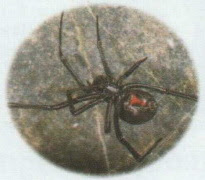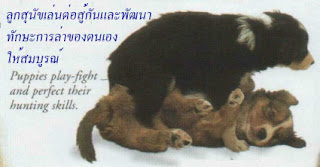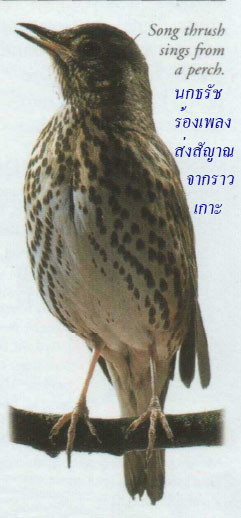Sign stimulus
In the spring, when these
freshwater fish breed, the male's throat and belly turn
red. If one male intrudes into the
territory of another male, its red colour acts
as a sign stimulus that produces a fixed-action
pattern: the occupying fish drives out
the intruder.
|
พฤติกรรมที่ถูกกระตุ้นโดยสิ่งเร้าจากภายนอก
ในฤดูใบไม้ผลิ
เมื่อปลาน้ำจืดเหล่านี้ผสมพันธุ์ ลำคอและช่องท้องของตัวผู้จะกลายเป็นสีแดง ถ้าตัวผู้ตัวหนึ่งบุกรุกเข้าไปในแดนของตัวผู้อีกตัวหนึ่ง
สีแดงจะแสดงออกมาเป็นพฤติกรรมที่ถูกกระตุ้นโดยสิ่งเร้าจากภายนอกซึ่งก่อให้เกิดพฤติกรรมที่มีแบบแผนแน่นอน
ปลาที่เป็นเจ้าของพื้นที่จะขับไล่ปลาตัวที่บุกรุกออกไป
|
|
2. Learned behaviour
Learning occurs when
an animal adapts to its surroundings by changing its
behaviour. By responding to experiences and adapting to changing conditions, an animal increases its
chances of survival. Learning takes time, and
animals that are dependent on learned behaviour have
long lives and large brains.
|
2. พฤติกรรมได้รับจากการเรียนรู้
การเรียนรู้จะเกิดขึ้นเมื่อสัตว์ปรับตัวเข้ากับสภาพแวดล้อมด้วยการเปลี่ยนแปลงพฤติกรรม
สัตว์จะเพิ่มโอกาสที่จะมีชีวิตอยู่รอดได้ด้วยการตอบสนองต่อประสบการณ์และการปรับตัวเข้ากับสภาพที่เปลี่ยนแปลง
การเรียนรู้จะมีอยู่ตลอดเวลา
และสัตว์ที่อาศัยพฤติกรรมที่ได้รับการเรียนรู้จะมีชีวิตที่ยืนยาวและสมองขนาดใหญ่
|
|||
Trial and error
learning
An animal will
associate an action it carries out with a successful
result, such as getting food or defeating a rival. This "reward" motivates the animal to alter its behavior to improve the result of future actions.
|
การเรียนรู้จากการทดลองและความผิดพลาด
(ลองผิดลองถูก)
สัตว์จะทำกิจกรรมรวมกันเป็นกลุ่ม จึงจะบรรลุผลสำเร็จอย่างสมบูรณ์
เช่น การกินอาหารและการต่อสู้กับศัตรู ผลตอบแทนนี้จะเป็นแรงจูงใจให้สัตว์ปรับเปลี่ยนพฤติกรรมเพื่อปรับปรุงผลการกระทำในอนาคตให้ดีขึ้น
|
Learning tool use
Some animals learn
to use simple "tools" in
order to feed. Sea otters, found
off the coast of California, USA, swim on their backs
with a stone on their chests on which they
smash the shells of clams and mussels to get at the
juicy contents. Young otters learn tool use from their parents.
|
การใช้เครื่องมือในการเรียนรู้
สัตว์บางชนิดจะเรียนรู้ในการใช้เครื่องมือง่าย ๆ เพื่อกินอาหาร นากทะเลที่พบนอกฝั่งทะเลแคลิฟอร์เนีย สหรัฐอเมริกา จะว่ายน้ำด้วยหลังมีหินอยู่บนหน้าอกเพื่อจะทุบเปลือกหอยกาบและหอยจำพวกหอยแมลงภู่เพื่อเอาเนื้อในที่เป็นน้ำฉ่ำ
|
|
Imprinting
This
is shown by some young animals that make a strong bond
with their parent soon after hatching or birth. Young ducklings, for example, stay close to their mother and improve their chances of survival under her protection.
|
พฤติกรรมการเรียนรู้แบบฝังใจ
ลูกสัตว์เล็ก ๆ
บางชนิดจะแสดงพฤติกรรมนี้เพื่อสร้างความผูกพันอย่างเข้มแข็งกับพ่อแม่ในทันทีทันใดหลังจากฟักออกจากไข่หรือเกิดมา
ยกตัวอย่าง ลูกเป็ดตัวเล็ก ๆ จะอยู่ใกล้ชิดกับแม่และมีโอกาสที่จะอยู่รอดมากขึ้นด้วยการปกป้องจากแม่เป็ด
|
Insight
learning
This
involves a form of reasoning. Some
animals can solve new problems by drawing on past experiences. Chimpanzees, having learned to extract termites or ants
from a nest with a stick, can exploit any shape or size
of nest.
|
การเรียนรู้แบบใช้เหตุผล
พฤติกรรมนี้เกี่ยวกับรูปแบบการใช้เหตุผล สัตว์บางชนิดสามารถแก้ปัญหาใหม่ ๆ ได้ด้วยการอาศัยประสบการณ์ที่ผ่านมา ลิงชิมแปนซี เมื่อเรียนรู้การใช้กิ่งไม้เขี่ยปลวกหรือมดออกจากรัง จะสามารถใช้ประโยชน์จากรังรูปแบบหรือขนาดใดก็ได้
|
|
Communication
Animals communicate
by sending out signals that are recognized by
other animals and
alter their behaviour in some way. The signals can be sights, sounds, or scents. Communication is used, for example, to
find a mate, threaten rivals or enemies, defend a territory, warn of danger, or hold a
group together.
|
การสื่อสาร
สัตว์จะติดสื่อสารกันด้วยการส่งสัญญาณออกไปซึ่งสัตว์อื่น
ๆ จะรู้รับได้และเปลี่ยนพฤติกรรมในบางแนวทาง สัญญาณอาจจะเป็นสายตา เสียง หรือ
กลิ่น ยกตัวอย่างเช่น สัตว์จะใช้การสื่อสารเพื่อหาคู่ผสมพันธุ์
ข่มขู่ข้าศึกหรือศัตรู ปกป้องเขตแดน เตือนอันตราย หรือ เกาะกลุ่มกัน
|
|
Visual
signals
Animals
may use visual signals as a threat or to attract a mate. This puss moth caterpillar adopts a warning posture
if threatened by an enemy. An enemy that ignores the warning is rewarded with a stinging
squirt of formic acid.
|
การสื่อสารด้วยท่าทาง
สัตว์อาจจะใช้การสื่อสารด้วยท่าทางเป็นการขู่หรือดึงดูดคู่ผสมพันธุ์ก็ได้ หนอนผีเสื้อตัวนี้ใช้ท่าทางเตือนถ้าถูกศัตรูข่มขู่ ศัตรูที่ไม่รู้จักการเตือนจะถูกพ่นด้วยกรดฟอร์มิก
|
|
Chemicals
Some animals release
chemicals called pheromones,
which, when detected, affect the behaviour of other
members of the same species. Female
gypsy moths release pheremones that attract males from several kilometres away.
|
สารเคมี
สัตว์บางชนิดจะปล่อยเคมีที่เรียกว่า
ฟีโรโมน ออกมาเมื่อมันถูกค้นพบ ซึ่งสารชนิดนี้จะส่งผลกระทบต่อพฤติกรรมของสมาชิกตัวอื่นในพวกเดียวกัน
ผีเสื้อกลางคืน (gypsy
moth) ปีกสีเหลืองตัวเมียจะปล่อยสารฟีโรโมนดึงดูดตัวผู้ซึ่งอยู่ไกลหลายกิโลเมตร
|
|
|
|
||
|
Sound
Many animals, including crickets, bullfrogs, peacocks,
and whales, use sound to communicate. This male song thrush sings to proclaim his
territory, to warn rivals to stay away, and to attract a female.
|
|
เสียง
สัตว์จำนวนมาก
ประกอบด้วยจิ้งหรีด กบอเมริกันตัวใหญ่ นกยูง และปลาวาฬ
จะใช้เสียงในการติดต่อสื่อสาร นกธรัชที่มีเสียงไพเราะตัวผู้จะส่งสัญญาณประกาศเขตแดนของตนเอง
เพื่อเตือนศัตรูให้ออกไปและดึงดูดตัวเมีย
|











